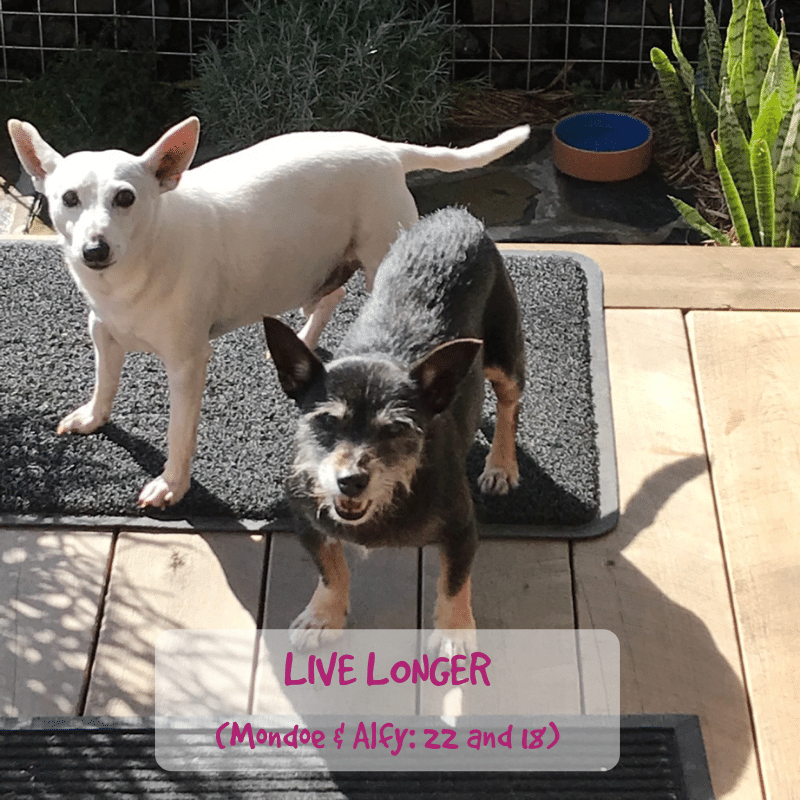As dogs age, their brains age too, and this can affect learning and memory function. In fact, dogs’ mental decline closely mimics human cognitive decline, which is why dogs are often used as a ‘medical model’ for human dementia.
However, whilst brains are ageing, not all of us will experience cognitive dysfunction. For those people and dogs who do, this mental deterioration won’t improve without treatment. And while we may be able to go to dance classes, learn a language, or do puzzles, to keep our brains healthy (Sudoku anyone?), our dogs don’t quite have the same options…
In this article we:
- Debunk confusing terms related to dementia
- Briefly explain the causes of dementia
- Describe the signs of dementia in our furry friends
- Suggest ways we can help reduce or delay the risk of cognitive decline
What is doggy dementia?
Alzheimer's disease, dementia and cognitive decline are all terms that most people understand as conditions related to memory, personality, and reasoning changes in humans. They also relate to dogs in much the same way.
Dementia and cognitive decline are used as general descriptions and Alzheimer’s disease refers specifically to the most common type of dementia.
There’s another common term used with people and dogs, ‘sundowner syndrome’, and it describes behavioural changes towards the end of the afternoon or late in the evening that can also be a sign of reduced cognitive function. Who knew the cocktail hour was a particularly bad one?
What causes dementia in dogs?
With increasing age, dogs develop a form of neurodegenerative disease, which has many similarities to age-related cognitive impairment and Alzheimer’s disease in humans. It’s typically associated with a decline in cognitive functions such as learning, memory, attention, cognitive flexibility, and executive functions in humans, monkeys, rats, and dogs.1But, how and why does this happen?
Reactions in the cells of all organisms produce reactive oxygen species as by-products of their normal metabolism. The balance between the detoxification of these harmful products and reparation of existing damage is important. However, as most species age, they accumulate oxidative damage in their cells as the efficiency of this process changes.2
The brain, due to its high oxygen requirements, is particularly susceptible to this process. Over time, oxidative damage (also known as oxidative stress) can result in the formation of proteinaceous plaques called amyloid which studies suggest have a role in the development of Alzheimer’s disease in humans. 2,3,4
The cause of dementia in dogs is not exactly known, but studies suggest that both oxidative damage and increased beta-amyloid load in the canine brain are potential factors leading to cognitive dysfunction.5
What are the signs of dementia in dogs?
The chances of our pets showing symptoms of dementia as they get older are pretty high. One study estimated that the prevalence of cognitive decline in dogs over the age of 15 could be as high as 68%.6
The major signs of cognitive dysfunction in dogs and cats have been summarised by the acronym DISHAAL:
- Disorientation - often seeming to be a little lost
- Interactions changes - such as altercations with owners, other pets, and the environment
- Sleep-wake cycle disturbances - such as the ‘sundown syndrome’ mentioned above
- House soiling - having accidents in the house
- Activity changes
- Anxiety - such as new fears or inappropriate barking
- Learning and memory deficits.7
Dementia in dogs is hard to diagnose and typically based on observation of the above signs and a vet ruling out other health conditions that could cause behavioural changes such as tumours, hormonal imbalances, long term pain, metabolic problems and vision or sight loss.
If you think that your dog may be suffering from dementia, it’s best to arrange a consultation with your vet.
What can we as pet parents do to help?
There are two key approaches we can take: diet and enrichment.
Studies testing the ability of dietary intervention with specific nutraceuticals to delay cognitive decline, have given positive results.8
For example, the clinical trials on which bestie’s antioxidant-rich Einstein gummy chew is based, involved 48 beagles, and ran over a two-year period. The Einstein includes vitamin E, which acts to protect cell membranes from oxidative damage and vitamin C, essential in maintaining oxidative protection for the soluble phase of cells as well as preventing vitamin E from propagating free radical production.
Blueberries are also a key ingredient. Rich in anthocyanins, the phytochemical compounds that give berries their pigment, are a great source of antioxidants. Anthocyanins can protect against—and even reverse—declines in cognitive function due to age-related oxidative stress.9
The Einstein also includes gingko, another herb that’s shown to have a positive impact on ‘disturbed’ geriatric behaviour in dogs and improving ‘canine short-term memory performance.’5
However, the beagle study mentioned earlier, also shows that enrichment activities are also effective in delaying cognitive decline. And in a case of 2 + 2 = more than 4, the two done together, ie nutraceutical AND enrichment, achieve better outcomes for senior dogs than either one on their own. (You can read a little more about that research here.)
General examples of behavioural enrichment include:
- Puzzles with food rewards
- Giving pets new toys to play with
- Going for interesting walks
- Playing with them (for example hide and seek)
- Teaching dogs tricks and rewarding them after
- Hiding treats or toys for them around the house.
However, for a list of activities specifically for seniors, check out our article Enrichment Activities for Senior Dogs.
Regardless of whether your senior dog is showing signs of cognitive decline or not, it’s always nice to make sure that their living environment is as easy for them to navigate as possible. For example:
- Provide calm areas for resting when needed (away from children or other pets)
- Introduce changes to the household more slowly to give them time to adapt
- Help them take more frequent toilet breaks.

Charlotte Franscesca Stiles
Charlotte is a 5th-year veterinary medicine student at the University of Zagreb, Faculty of Veterinary Medicine. She is a volunteer at her university's obstetrical clinic, equine clinic, an editor of her university's scientific journal, and dog mum to 12-year-old Chiki.
Charlotte is particularly interested in wildlife medicine and research and hopes that her current extra-curricular work as a student in this area will help her achieve a scientific career after graduation.
References
1.Chapagain, D., Virányi, Z., Huber, L., Serra, J., Schoesswender, J., & Range, F. (2018). Effect of age and dietary intervention on discrimination learning in pet dogs. Frontiers in psychology, 2217.
- Head, E. (2009). Oxidative damage and cognitive dysfunction: antioxidant treatments to promote healthy brain aging. Neurochemical research, 34(4), 670-678.
- Rofina, J. E., Singh, K., Skoumalova-Vesela, A., van Ederen, A. M., van Asten, A. J., Wilhelm, J., & Gruys, E. (2004). Histochemical accumulation of oxidative damage products is associated with Alzheimer-like pathology in the canine. Amyloid, 11(2), 90-100.
- Hardy, J. A., & Higgins, G. A. (1992). Alzheimer's disease: the amyloid cascade hypothesis. Science, 256(5054), 184-185.
- Araujo, J. A., Landsberg, G. M., Milgram, N. W., & Miolo, A. (2008). Improvement of short-term memory performance in aged beagles by a nutraceutical supplement containing phosphatidylserine, Ginkgo biloba, vitamin E, and pyridoxine. The Canadian Veterinary Journal, 49(4), 379.
- Neilson, J. C., Hart, B. L., Cliff, K. D., & Ruehl, W. W. (2001). Prevalence of behavioral changes associated with age-related cognitive impairment in dogs. Journal of the American Veterinary Medical Association, 218(11), 1787-1791.
7.Landsberg, G. M., Deporter, T., & Araujo, J. A. (2011). Clinical signs and management of anxiety, sleeplessness, and cognitive dysfunction in the senior pet. The Veterinary clinics of North America. Small animal practice, 41(3), 565–590.
- Milgram, N. W., Head, E., Muggenburg, B., Holowachuk, D., Murphey, H., Estrada, J., ... & Cotman, C. W. (2002). Landmark discrimination learning in the dog: effects of age, an antioxidant fortified food, and cognitive strategy. Neuroscience & Biobehavioral Reviews, 26(6), 679-695.
- W. Jean Dodds, DVM, Hemopet, DOG SYMPOSIUM 2016, Oslo, Norway, Nutrition and Thyroid Function Affect Canine Behavior and Cognition















